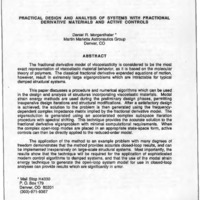Practical Design and Analysis of Systems With Fractional Derivative Materials and Active Controls
Item
-
Title
-
Practical Design and Analysis of Systems With Fractional Derivative Materials and Active Controls
-
Report Number
-
WL-TR-91-3078 Volume I, p. BCA-1 thru BCA-28
-
Creator
-
Morgenthaler, Daniel A.
-
Corporate Author
-
Martin Marietta Astronautics Group
-
Laboratory
-
Wright Laboratory
-
Date
-
1991
-
Date Issued
-
1991-08
-
Extent
-
28
-
Contract
-
Laboratory Reseach - No Contract
-
DoD Project
-
2401
-
DoD Task
-
240104
-
Identifier
-
ADA241311
-
Format
-
1 online resource
-
Abstract
-
The fractional derivative model of viscoelasticity is considered to be the most exact representation of viscoelastic material behavior, as it is based on the molecular theory of polymers. The classical fractional derivative expanded equations of motion, however, result in extremely large eigenproblems which are intractable for typical damped structural systems. This paper discusses a procedure and numerical algorithms which can be used in the design and analysis of structures incorporating viscoelastic materials. Modal strain energy methods are used during the preliminary design phases, permitting inexpensive design iterations and structural modifications. After a satisfactory design is achieved, the solution to the problem is then generated using the frequency-dependent complex impedance matrix implied by the fractional derivative model. The eigensolution is generated using an accelerated complex subspace iteration procedure with spectral shifting. This technique provides the accurate solution to the fractional derivative eigenproblem with minimal computational requirements. When the complex open-loop modes are placed in an appropriate state-space form, active controls can then be directly applied to the reduced-order model. The application of the method to an example problem with many degrees of freedom demonstrates that the method provides accurate closed-loop results, and can be implemented inexpensively on large-scale structural systems. Most importantly, the results show that the technique will be required for the application of sophisticated modern control algorithms to damped systems, and that the use of the modal strain energy technique to generate the open-loop system model for use in closed-loop analyses can provide results which are significantly in error.
-
Distribution Classification
-
1
-
Distribution Conflict
-
No
-
DTIC Record Exists
-
No
-
Illinois Tech Related
-
No
-
Photo Quality
-
Complete
-
Report Availability
-
Full text available
-
Type
-
article
 article09
article09